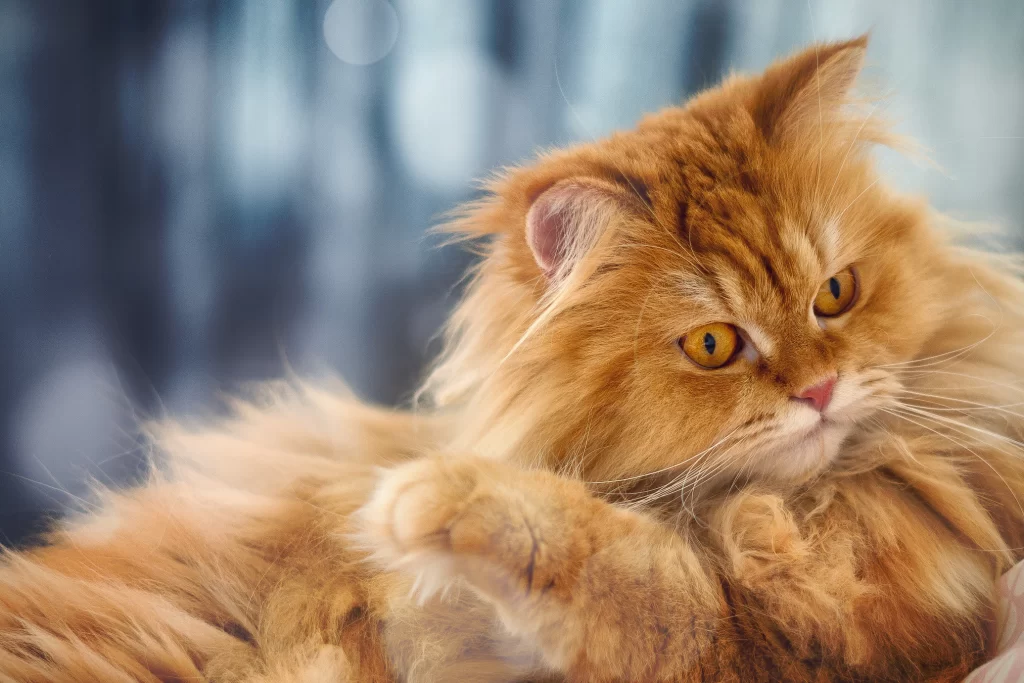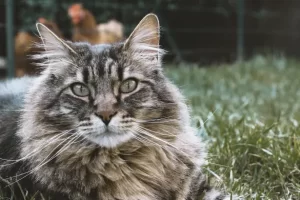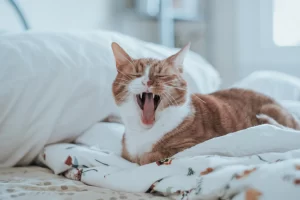Last updated on February 20th, 2023 at 12:56 am

Whenever it comes to fleas on your cat, prevention is always the preferable treatment option. Preventing an infestation is far simpler than getting rid of fleas after they have overtaken your cat or your house. Numerous medications are undoubtedly available at drugstores and through your veterinarian that kill fleas with harsh chemicals, but did you also know that there are equally efficient organic, safe, and chemical-free remedies? These therapies work exceptionally well for cats whose immune systems are weak, those with sensitive skin, and those whose cat parents want a more natural way of life. Consider using natural ways to get rid of fleas on cats because they are safe for your pet.
How to check for fleas on cats?
Consider your suspicions regarding the presence of fleas on your cat before a flea hunt. If you’ve noticed fleas on the cat or even in your home, you should apply a cat-specific veterinarian flea treatment. However, you may still have a flea problem even if you have never noticed a flea on your pet. It’s also possible that flea eggs dropped from your pet will hatch in a few days. In any case, it’s critical to establish with certainty whether the cat has fleas or not.
It is best to begin by inspecting their fur. Start by using a flea comb on your cat’s fur. A flea comb is specially designed with close-set teeth that are able to pick up fleas and flea dirt, which is the dried blood that fleas leave behind. Comb your cat’s fur in several different areas and slowly move the comb through the fur. If you see anything that looks like black pepper, this is flea dirt and an indication that your cat has fleas.
Next, you should use a flashlight to inspect your cat’s skin. Look for small black bugs, as these are most likely fleas. You may also see tiny red bumps or scabs on your cat’s skin, as fleas can cause irritation and itching. If you see any signs of fleas, it is important to take your cat to the vet for a flea treatment.
Where do fleas like to hide?
Fleas are experts at staying hidden, so just because you can’t immediately see them doesn’t mean they aren’t around. The following list includes some of their preferred hiding places on your pet and in your house.
In cats, fleas tend to gather in a wide range of areas in the body of cats. According to studies, the head and neck of cats have the highest density of fleas, while the limbs and tail have the lowest density. Skin inflammation on or near the neck is joint in cats with flea hypersensitivity reactions. It might be challenging to see fleas on your pet; instead, check for “flea dirt,” often known as flea faeces. Flea dirt resembles coffee grounds, but when placed on white paper and given a little water mist, you can see that it is red, the color of digested blood.
You’re more likely to discover more eggs and larvae in your pet’s resting area because fleas lay most of their eggs at night. Additionally, flea activity is not limited to your pet’s bed. Carpet and rugs also play an important role in hiding fleas. Flea larvae emerge from their eggs and travel toward the floor and away from light sources.
Depending on the flea’s life cycle, vacuuming may not be efficient in eradicating them because they frequently travel deeply within the carpets and feed on organic waste and flea excrement. Regular vacuuming of a pet’s sleeping areas can eliminate up to 80% of flea eggs, but it works far less well on larvae. When larvae ultimately transform into pupae, a new problem emerges. Pupae readily conceal themselves with environmental debris because they are sticky. Due to their stickiness, mechanical removal from the surroundings by vacuuming is challenging.
Flea eggs, larvae, and pupae frequently conceal themselves behind shrubs, trees, and other vegetation in moist, shady locations. Due to their susceptibility to drying and freezing, flea eggs and larvae are less likely to be discovered in regions that receive a lot of sunlight, such as the center of the grass.
Removal of organic matter mounds and keeping trees, bushes, and other plants trimmed to eliminate flea habitats is a way of preventing fleas. Applying diatomaceous mud to flea-friendly locations is another option. Diatomaceous earth, a powder formed from the remnants of aquatic creatures called diatoms, is a well-liked natural flea control treatment. Fleas dehydrate and die from being sliced by the exoskeletons of the fossilized diatoms when they crawl over the powder. Birds, animals, and fish are not at risk from diatomaceous earth.
Causes of fleas
Before you can learn the natural ways to get rid of fleas on cats, you also need to learn about their causes. Outdoor cats come into contact with fleas in their natural surroundings, and because they are the intermediate host for these parasites, they unknowingly gather them. Cats outside can pick up fleas from the dogs that roam around (cat fleas happily infest dogs, too). Certain elements might make it more likely for a cat to attract fleas, such as:
Other pets living in the home
Fleas can easily be transferred from one animal to another, so if there are other pets in the house, such as dogs or rabbits, the risk of fleas spreading to the cat increases. Similarly, if the cat spends time visiting other homes with pets, then the chances of picking up fleas from those animals is also increased.
Getting a new home
Moving into a new home frequently means that it is entirely vacant and that the fleas have also left. If you’ve just moved in with your cat, think about doing a complete cleaning once more or perhaps hiring professional flea treatment services if you believe it’s required. by doing so, you will be able to control the fleas in your new home.
Pests in the backyard
Cats adore going on quick hunts for mice. But they can readily switch sides and infect your cat if one of their victims is the host of a few pairs of fleas.
Long grass
Fleas are typically found outside in untidy grassy places where they may readily hide and mount an approaching animal. Your cat’s fleas might result from an excursion through the fields or forests, an unkempt yard, or both. You should Keep your yard neat with frequent mowing if you wish to reduce the exposure of your animals to fleas there.
Natural ways to get rid of fleas on cats
Fleas can be an irritating problem for cats and can cause serious health issues if left unchecked. Fortunately, there are several natural ways to get rid of fleas on cats. These methods can be used to help prevent an infestation in the first place or to get rid of existing fleas. Here are some ways:
Use a flea comb
Regularly grooming your cat is the most important thing you can do to prevent a flea infestation. Brushing your cat daily will remove fleas and eggs, preventing them from proliferating in your home. There are specially designed combs that have very fine teeth and can be used to comb through your cat’s fur, trapping and removing fleas.
Lemon juice
The acidic properties of lemon juice make it an effective flea repellent. When applied to the fur of cats, lemon juice can help kill fleas and their eggs. It also helps to keep new fleas away. Lemon juice is a safe and natural way to get rid of fleas on cats. To use lemon juice to get rid of fleas on cats, start by mixing one part lemon juice with two parts water. This solution should be applied to a clean cloth and rubbed onto the fur of the cat. It is important to not get the solution in the cat’s eyes or ears. Leave the solution on the cat for 10 minutes, and then rinse it off with warm water. It is important to repeat this process a few times a week to ensure that all of the fleas are eliminated.
Lavender
Lavender is a potent, quick-acting flea repellent and a gentle approach to calm your pet’s skin. It may even assist the cat take a quick sleep. Several tests found that diluted lavender flea-killing solutions were equally effective as conventional chemical sprays. Use fresh lavender in your house by steeping it in water overnight, then straining the mixture and misting it on your cat’s coat (no need to rinse).
Loose chamomile tea
This is another substance known for healing the skin and may also be used to kill fleas on your cat. Steep the tea, let it cool completely and then use the liquid to massage your cat’s coat. You can repeat both remedies every day.
Cedar Chips
Cedar chips are a natural flea repellent for cats. They are an effective, safe, and affordable way to protect your feline companion from fleas. Once you have the chips, spread them around your cat’s sleeping area, such as their bed or a corner of the living room. To ensure the cedar chips are effective, it is important to vacuum the area frequently. This will help to remove any fleas that have managed to get past the cedar chips. It is also important to change the cedar chips regularly. This will ensure that the scent is strong enough.
How to prevent fleas in the future
Stopping a flea infestation may be a nightmare once it’s started which is why you need the above natural ways to get rid of fleas on cats. Professional pest control services have the knowledge and tools to prevent ongoing infestations and stop new fleas from moving into your house. They may also advise you on how to safely use flea control products around your cats and identify trouble areas in your home. During the peak flea season, several companies also provide follow-up services to check your property. Although professional services might be pricey, they are frequently quicker and less expensive than trying to solve the issue alone.
Many of the eggs, larvae, and pupae that are growing within the home are removed by vacuuming. Furthermore, vacuuming encourages fleas to break out of their insecticide-resistant cocoons sooner, accelerating their treatment exposure. Vacuuming enhances the insecticide’s penetration down to the base of the carpet fibers where growing fleas dwell by elevating the carpet nap. Thoroughly vacuum all areas, especially places where cats relax or sleep. Remember to vacuum below furniture, cushions, mattresses, throw rugs, and around room boundaries. After cleaning, place the vacuum bag into a trash bag and throw it away outside.
Adult fleas can be caught in flea traps with a light and a glue board, which can also be used to track the effectiveness of therapy. Without employing other techniques, the traps will not be able to get rid of an infestation. An alternating on-off (green) light is used in one of the market’s most successful flea traps to mimic the shadow of an approaching animal. According to research, fleas react more favorably to green light than other wavelengths.
Conclusion
In conclusion, it is very important to get expert guidance from your veterinarian on keeping fleas from ever setting up residence on your cat. The most straightforward approach to stop fleas from migrating is to use your veterinarian’s advice for year-round prevention. Products like topical flea treatments and cat flea collars can help ensure your cat is safe. You’ll need to know how to get rid of fleas if you can’t successfully prevent them. All in all, the above natural ways to get rid of fleas on cats will serve the purpose of ensuring the health of your cat and the environment is kept.
Additional Resources:
Top 15 Common Cat Health Problems
My Cat Vomits After Eating! What To Do?


